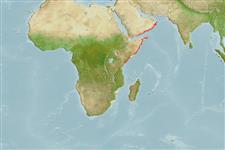>
Ovalentaria/misc (Various families in series Ovalentaria) >
Pseudochromidae (Dottybacks) > Pseudochrominae
Etymology: Pseudochromis: Greek, pseudes = false + Greek, chromis = a fish, perhaps a perch (Ref. 45335).
Environment: milieu / climate zone / depth range / distribution range
นิเวศวิทยา
เกี่ยวกับทะเล,น้ำเค็ม เกี่ยวกับหินโสโครก; ระดับความลึก 1 - 8 m (Ref. 11441). Tropical
Western Indian Ocean: Kenya, Oman and Socotra Archipelago.
ขนาด / น้ำหนัก / Age
Maturity: Lm ? range ? - ? cm
Max length : 9.0 cm TL เพศผู้/กระเทย; (Ref. 11441)
Short description
เครื่องมือที่ใช้ในการแยกชนิดสัตว์,สิ่งมีชีวิตออกจากกัน | สัณฐานวิทยา | ความยาวต่างๆ
เงี่ยงครีบหลัง (รวม) : 3; ก้านครีบอ่อนที่หาง (รวม) : 28 - 32. This species distinguished by the following characters: 28-32 segmented dorsal-fin rays, all or all but the first 1-2 rays branched; 17-20 segmented anal fin rays; 16-20 circumpeduncular scales; dorsal fin origin to pelvic-fin origin 22.7-27.1% SL; head and body generally brown with darker brown edging on body scale margins and a dark grey to dark blue (dark grey to dark brown when preserved) spot on opercular flap (Ref. 81967).
Life cycle and mating behavior
วัยเจริญพันธุ์ | การสืบพันธุ์ | การวางไข่ | เซลสืบพันธ์ของเพศเมีย(ไข่) | ความดกของไข่ | ตัวอ่อน
Gill, A.C. and J.K.L. Mee, 1993. Notes on dottyback fishes of the genus Pseudochromis of Oman, with description of a new species (Perciformes: Pseudochromidae). Rev. Fr. Aquariol. 20(2):53-60. (Ref. 12720)
IUCN Red List Status (Ref. 130435: Version 2024-2)
Threat to humans
Harmless
Human uses
เครื่องมือ
Special reports
Download XML
แหล่งที่มาจากอินเตอร์เน็ต
Estimates based on models
Preferred temperature (Ref.
123201): 26.2 - 28.5, mean 27.1 °C (based on 288 cells).
Phylogenetic diversity index (Ref.
82804): PD
50 = 0.5000 [Uniqueness, from 0.5 = low to 2.0 = high].
Bayesian length-weight: a=0.01148 (0.00474 - 0.02781), b=2.95 (2.74 - 3.16), in cm total length, based on LWR estimates for this (Sub)family-body shape (Ref.
93245).
ระดับชั้นอาหาร (Ref.
69278): 3.5 ±0.5 se; based on size and trophs of closest relatives
Fishing Vulnerability (Ref.
59153): Low vulnerability (10 of 100).
